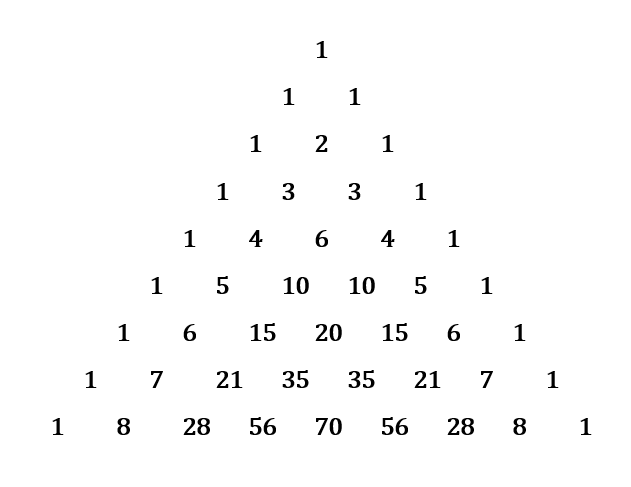Explanation of Mathematics

Pascal’s discovery led to the theory of Probability, which is, “The mathematical framework that allows us to analyze chance events in a logically sound manner.” (Brown) Blaise Pascal used Pascal’s triangle to predict probability using combinations. A simpler way to understand this is by using an example aside from gambling. Take, for example, if the Yankees and the Braves are playing each other in baseball 5 times, and someone wants to find all the different possibilities for the number of games the Yankees could win. Since it is known there are 5 games, it indicates the use of the fifth row of Pascal’s Triangle which reads: 1 5 10 10 5 1, as shown in the figure above. From here one can use combinations to find the total number of different possibilities for the game outcomes, but one must skip the first ‘1’ in the row. For example, the total number of possibilities for the Yankees to win 2 games is 10, 3 games is 10, 4 games is 5, and all 5 games is 1. (Mlodinow, pg. 100) The probability of winning 2 games would then be the combination 2 choose 5, divided by the row total: (10)/(1+5+10+10+5+1) = 10/32 = 31.25%.
Referring back to Pascal’s ‘problem of points’, it was solved using a similar, but slightly different, idea. However, it is equally effective as the baseball problem above. Depending on how many more points were needed by each player to win, those points were added together. Then, whatever sum you got is the line on the triangle used to calculate the probable winnings of each player. Again, depending on the points each player needs, you find the sum of the first “x points” divided by the total of the row, (however, this time including the first ‘1’.) This indicates what proportion each player will take to end the game fairly. (Simpson) This alternative way simply shows that there are multiple ways to use Pascal’s triangle to find probabilities that will result in the same needed answer.
There are several theories of probability. The theory of probability already discussed thus far is the Theory of Equally Likely Outcomes. It originated in gambling games, but can also be used to find probabilities when flipping coins, rolling dice, etc. (Stark, 2019) It’s important to note the difference between conditional and unconditional probabilities in the Theory of Equally Likely Outcomes. First, conditional probabilities. Instead of playing a game of chance, say someone wants to find the proportion of girls in a high school class who got 100% on a certain test. When computing this probability, the total number of outcomes can only equal the number of girls in the class. If the boys were included the probability would be incorrect. Therefore, if there are 30 students in the class, 15 boys and 15 girls, and 2 girls got 100%, the fraction should equal 2/15 and not 2/30. (LaMorte, 2016) This is different from Pascal’s first question about getting at least one pair of double sixes in 24 rolls of two dice, where the answer, using the subtraction rule, would be 1 – (35/36)^24 = 0.4914. (Simpson) This is an unconditional probability because the total number of outcomes is always 36 every 24 times the dice are rolled. (Note the subtraction rule is being used here, which is 1 – P(opposite event), and the opposite event is that no double sixes are rolled. Since there are 36 total outcomes when rolling two dice, only one of those outcomes has a pair of sixes, so 35 outcomes are not. Since there are 24 rolls of the dice, the probability comes out to be: 1 – (35/36)^24.)
Another probability Theory is known as the Frequency Theory. In frequency theory, probabilities are always between 0-100%. The idea of the theory is that the more times an experiment is repeated, the closer the end proportion will get to the true probability. For example, the more times a person flips a coin, the closer the probability will get to 50%. (Stark, 2019)
The last Theory of Probability is The Subjective Theory. This is used when trying to express the probability of a single event occurring. For example, if a geologist is 25% sure there will be an earthquake, there is also a 75% chance there will not be an earthquake. It would be too difficult to assign a probability such as this using the other theories of probability. (Stark, 2019)
Problem of Points Applet
| Applet |
Description |
|
An applet that shows the solution to Pascal's Problem of points. Scroll down for questions to ponder and find solutions to! |

